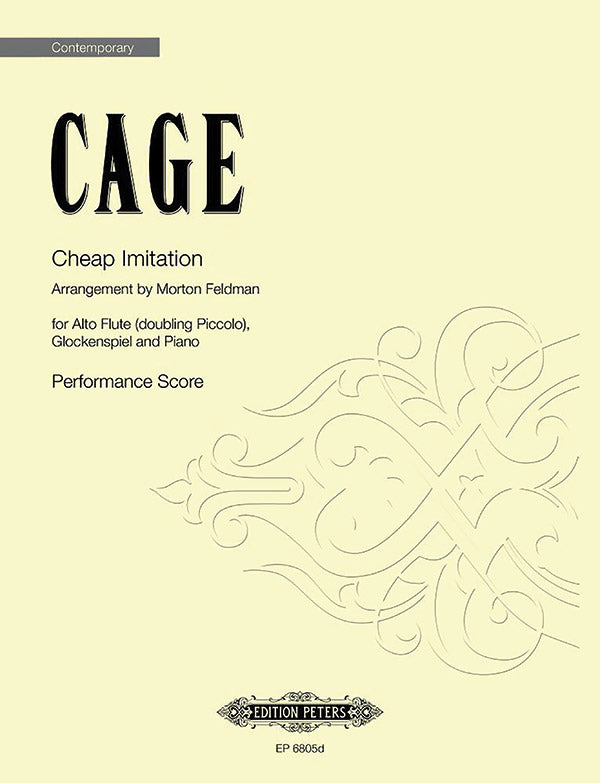John Cage
John Cage: Cheap Imitation (arr. for Alto Flute (Doubling Piccolo), Glockenspiel, and Piano)
- Composer: John Cage (1912-1992)
- Arranger: Morton Feldman (1926-1987)
- Format: Performance Score
- Instrumentation (this edition): Piano, Alto Flute, Glockenspiel
- Originally for: Piano
- Work: Cheap Imitation (1969)
- ISMN:
- Size: 9.1 x 11.9 inches
- Pages: 40
Description
In June of 1980, Aki Takahashi was preparing to leave Buffalo, New York. Morton Feldman, knowing her reputation as a pianist specializing in new music, had invited her to be an artist in residence at the university where he taught. But now it was time for her to go back to Japan. At their last meeting, Feldman gave a musical score to Takahashi as a gift. It was a copy of John Cage's solo piano piece Cheap Imitation with annotations by Feldman. He told her that this was an instrumental version of this piece for flute, piano, and glockenspiel. He signed the title page, just under the original title:
INSTRUMENTAL VERSION (Fl, Pf, Glock) Morton Feldman Buffalo, N.Y. Winter 1980 Dedicated to Aki Takahashi
Four different artists were bound up in this single gesture: John Cage, Erik Satie, Morton Feldman, and Aki Takahashi. The story of this gift, a story of memory and connection, unfolds over most of the 20th century.
John Cage was always devoted to the music of Eric Satie. in 1970 Cage was supposed to create a new two-piano transcription of Satie's Socrate for a Cunningham dance, but he was unable to get permission from the publisher. Even worse, he could not even get performance rights to use the published piano-vocal score of Socrate. Cage's creative solution was to make a piano piece that maintained the exact metrical and phrase structure of Satie's Socrate, but with different notes, thus avoiding copyright issues. He called this piece Cheap Imitation. Cunningham responded by calling his dance Second Hand.
Feldman arranged Cage's piano version of Cheap Imitation for a trio of flute (doubling on alto flute and piccolo), piano, and glockenspiel. This is the same instrumentation that was used in Feldman's 1978 Why Patterns? and which (somewhat expanded) was the basis for two of his Major works in the 1980s: Crippled Symmetry (1983) and For Philip Guston (1984). Feldman made his arrangement by simply taking the piano score of Cheap Imitation and adding indications about which notes were to be taken by the flute and which by the glockenspiel; unmarked notes were for the piano. Why did Feldman make this transcription? Takahashi didn't know; she was too moved by the gift to ask Feldman any questions about it.
This edition is the first published edition of Feldman's arrangement. It is a performance score. Three copies are needed for performance. The entire melody is printed in each part to facilitate continuity. The performers are only to play the large notes in their part.
Publishers use a lot of words to describe what they sell, and we know it can be confusing. We've tried to be as clear as possible to make sure you get exactly what you are looking for. Below are descriptions of the terms that we use to describe the various formats that music often comes in.
Choral Score
A score for vocalists that only contains the vocal lines. The instrumental parts are not there for reference. Generally, cheaper than a vocal score and requires multiple copies for purchase.
Facsimile
Reproductions of the original hand-written scores from the composer.
Full Score
For ensemble music, this indicates that the edition contains all parts on a single system (there are not separate parts for each player). In larger ensembles, this is for the conductor.
Hardcover
Hardbound. Generally either linen-covered or half-leather.
Orchestral Parts
Similar to a wind set, this is a collection of parts. In the case of strings, the numbers listed are the number of copies included, though generally these are available individually (often with minimum quantities required).
Paperback
When publishers offer multiple bindings (e.g. hardcover) or study scores, this is the "standard" version. If you're planning to play the music, this is probably what you want.
Performance / Playing Score
A score of the music containing all parts on one system, intended for players to share. There are not separate parts for each player.
Set of Parts
For ensemble music, this indicates that there are separate individual parts for each player.
Solo Part with Piano Reduction
For solo pieces with orchestra, this is a version that contains a piano reduction of the orchestra parts. For piano pieces, two copies are typically needed for performance.
Study Score
A small (think choral size) copy of the complete score meant for studying, and not playing. They make great add-ons when learning concertos and small chamber works.
Vocal Score
A score prepared for vocalists that includes the piano/organ part or a reduction of the instrumental parts.
Wind Set
For orchestral music, this is a collection of wind and percussion parts. The specific quantities of each instrument are notated.
With Audio
In addition to the printed music, the edition contains recordings of the pieces. This may be an included CD, or access to files on the internet.
With / Without Fingering (Markings)
Some publishers prepare two copies - a pure Urtext edition that includes no fingering (or bowing) suggestions and a lightly edited version that includes a minimal number of editorial markings.




